Task 2 Making a relationship
Making a relationship | Cheese string from Mohammed Osman on Vimeo.
The idea and development of the scene for me was to make a short comedy skit with 6 different shots showing a relationship between the two characters in my video. Before making this I learnt some aspects about blocking ‘determining where the actors will be on the set and the first camera position’ (Pasquine, F. (2009) basic rules of filmmaking which in the case was the 180 degree rule. For this I didn’t need to put that much emphasis on the relationship between the two characters since the story does the job it’s self which is one character buying cheese strings from another in a shady location.
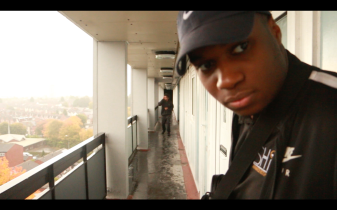
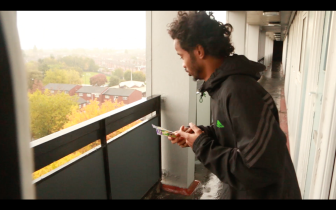
One of the techniques that I used for this task 2 making a relationship, was the rule of thirds. The purpose of this rule is to place major points of interest in the scene on any four intersections (Brown, B. (2011). The two images that I have embedded above show points in the video where I used rule of thirds to highlight the importance of the characters while also trying to show the background.
In addition to that, the 180 degree rule was a vital aspect this video in terms of blocking since it would create confusion for the audience if I didn’t use. For example if I was to change the position of my camera from one side to another it appear that the two characters changed position or that the location is different. Therefore I learnt the importance of the rule when it comes to blocking. It also made the map of the scene simpler for me since I knew I had to be on one side of the shot the whole time, therefore, I knew where everything had to be after every shot.
Moreover, I also used the shot reverse shot to convey that the two characters were communicating. Other shots I also used included a close up of the exchange of the money. This along with the grimy location and the attire of the two characters establishes that there is shady business going on between the two characters. I followed this up with a shot of Reginalds’ face looking around to see if anyone is looking as he’s going through his pouch. This makes Reginald look paranoid and makes the audience wonder what it is that he is hiding. The twist to the story was that it was cheese strings in Reginalds’ pouch and it was that which Hussein was desperate to obtain.
The POV shot of Reginald looking at Hussein wanting the cheese drugs shows the emotion of the character which was desperation and impatience. Emotion is 51% important (Chang, J. (2012) therefore this shot was one the key shots in my video since it shows that this character doesn’t possess power in the scene and he is dependent on Reginald to obtain the thing he wants establishing the relationship between the two characters. Furthermore, I wanted to show this scene from the point of view of Reginalds character as it is evidenced through the introduction of his character as well as the outro of him about to enter his flat.
For this scene blocking was fundamental since it mostly relied on the positioning of the character and the 180 degree rule. I feel like this piece achieved its purpose which was to be funny and the audience who have seen it laughed. However, I feel that the sound wasn’t good since it cut a lot in the background although I wanted to use ambient sound . Some shots I also felt weren’t that good for example the second last shot of Hussein walking away it was a little bit too long. Furthermore, although the location made sense it could have been better, Perhaps it could have been in an ally way. Furthermore, the background on pretty much all of the shots were over exposed and I feel that it slightly ruins my film.
Task 3 Lighting
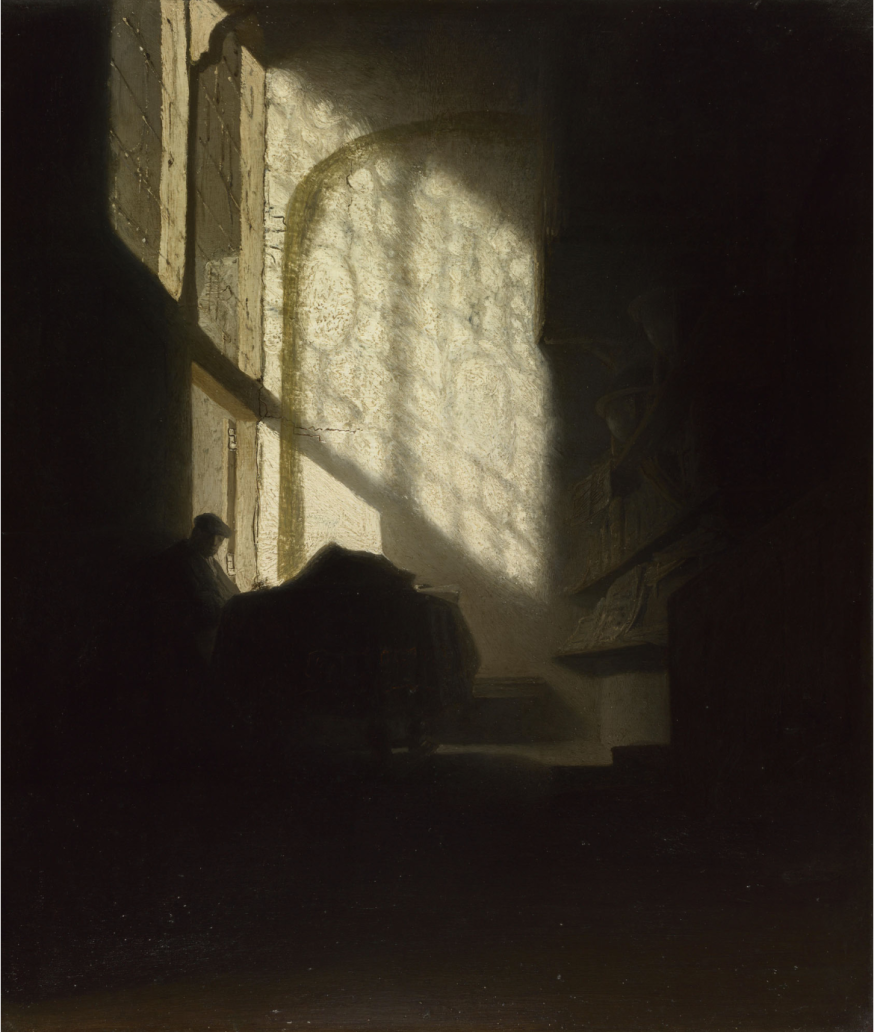
For this task we were given the image above and were assigned to make a short video a short film putting emphasis on the lighting. Before planning the shoot my peers and I first tried to analyse the image to develop a story. When we look at this image we feel that the character is perhaps in despair, has lost something or someone or is feeling alone. Looking at the lighting we can tell that it’s day but this particular character chooses to stay in the dark which gave us the idea to make a story of him having killed his wife and is in despair because of the actions he has committed.
For this task we were more focused on the production element on how we were going to create something similar to the image above. I went to check out Nelsons home and he has a large window at his house about a meter smaller then the one in the painting. During day time I thought that it wouldn’t create the same effect as we wanted so we therefore decided to wait till night and use the 800 watt lights to create the illusion of day. Our group understood that the filming during the day would cause over exposure and it’s harder that way to manipulate the lighting, therefore this technique worked to our advantage. This technique we used is called ‘night for day’ (RMansur (2008).
On the day of the shooting we started around 9pm. We placed 2 800 watts blondes outside the window with and placed it on an angle that made it look like the light was coming from above just like the sun.
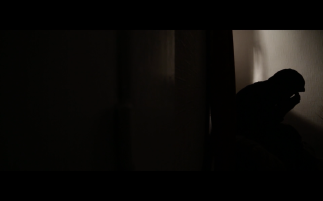
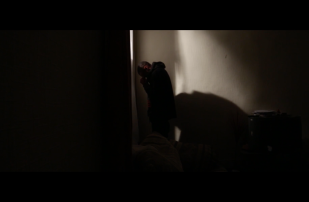
Because the narrative was simple and short with the character murdering his wife. To maintain interest we introduced the character using a dark silhouette and rule of thirds hiding the parts in front of him as there is a body there. Our intention with this is was that we didn’t want to reveal too much and and we also wanted to put emphasis on the darkness to create a more mysterious atmosphere. We then cut to a close up of Thais’ face with his bloody hand. Bit by bit we began to reveal more about what was going so the audience could see that he may have killed someone. The next important shot is of him looking out the window and bringing his hoodie down. Here we see the characters face and get a better view and understanding of his emotion. This shot is then followed by a long shot where we can see more of the room to build up to the part where we show the audience the body. We end the film with pan down on the body but don’t actually show because we decided that it would have a better effect if we left the audience guessing.
Overall in this video I think that we put more emphasis on the practical aspect and our creativity, I feel like we could have put more research on lighting techniques since this image and our final product is very similar to film noir in terms ‘low key lighting style: side lights and shadowy’ shots (Brown, B. (2016). Moreover, the technical aspect of this wasn’t to a standard and some mistakes are clear. For example, there was a shot where you could barely see anything since it’s too dark. Here what we should have done was to maybe increase the exposure of the camera or put more lighting in the room and edit it in post production. In addition to that the feedback that we got from the class and lecturers was that some of the shots were too dark and that sound could have enhanced it. Looking back I think we should have got sound equipment and out and recorded diegetic sound for example sounds of heavy breathing or crying.
260mc lighting from Josh Solomon on Vimeo.
Task 5 Short film
For this task we were assigned to make a short film where we would have to create an idea from the image above. My role for this production was to research the themes of the idea and to oversee the shoot. At the beginning what we took from this picture was that The lady with the shoe looked physically powerful, enraged, modern and scandalous. One other interpretation we took from her was that judging by her hairstyle and attire she looks independent and self made which gave us the idea that the character worked her way up the ladder. The lady on the floor laughing made us think that she’s maybe arrogant, Confident, manipulative, petty and spoilt. These interpretations gave us ideas in developing the characters Naomi(the main character) and Michelle.
To get a better idea of the story before we developed our script I research the theme of our initial idea which led us to female representation and feminism. Historically women have been represented as ‘unintelligent, or sexy, or as housewives responsible only for housework (Lumby, C. (1997). When thinking about our characters for the short film we wanted to correspond this type of stereotype with our character Michelle who is someone who obeys this stereotype and believes it.
This image fits the topic of the 2nd wave feminism which led all the way from the 60s to the 90s where sexuality and reproductive rights were dominant issues, and much of the movement’s energy was focused on passing the Equal Rights Amendment to the Constitution guaranteeing social equality regardless of sex(Rampton, M. (2015). We felt that the image was a reflection of the 2nd wave of feminism in terms of how the women looked and their style. The women standing up comes across as slightly masculine, with her sleeves showing and her muscles showing and also having broad shoulders. Moreover, Kristen McMenamy is known for her unusual and androgynous appearance which is completely opposite to conventional female stereotype. This made us think about making our protagonist about the women with the shoe, since she doesn’t conform to social ideals and eventually gains the respect of the CEO through her own hard work, whereas Michelle gets left behind in the dark because she limits herself with the conventional female roles.
One of the sources of inspiration for this them is that females have been historically underrepresented with only ’20 to 35 percent of characters’ being female between the 50s and the 70s (Gauntlett, D. (2008). Furthermore when ever women have been shown they usually play the housewife role and their roles often concerned with romance or family problems (Gauntlett, D. (2008). It has only been more frequent since 3rd wave feminism that we have seen females being represented differently with films like Silence of the lambs (1991) for example having a strong female lead. Our movie will represent the lead character Naomi as a hardworking and bright individual who can hold her own in a mans world.
In terms of the overseeing the production i couldn’t really do my job since literally everyone apart from myself and Jeremie. Furthermore, no one was communicating and people weren’t doing their jobs properly. For example, there were many shots where you could see the lighting or a camera person in the shot which meant we couldn’t use a lot of potentially good shots which made it very hard for us in the post production.
Another thing was which made this production very bad was the workload was done by mostly myself, Din and Jeremie while everyone else in the group didn’t bother either turning up to meeting or find actors and locations. It got to a point where we had so much work that we shot the film two days before the deadline which meant that we rushed it which had a negative impact on the overall production.
Overall I feel that this task had good potential since we separated the research between 4 people which gave us very good and straight forward blue print. The thing that brought us down was the fact that the teamwork was terrible since most of the people literally did nothing till the day of the shoot and didn’t know enough about the story and script.
260MC Task 5 The Film – The Meeting from Mohammed Osman on Vimeo.
Task 7 Remake
For this task i remade the one task that I felt that I could have made better which was the portrait of my friend Hussein. When making this portrait video I wanted to stick to create something natural and organic which in this case was Husseins’ genuine emotion. I staged a prank call on my friend telling his twin brother to tell him any distressing news that would get Hussein feeling either angry or sad. In this case he told him that his sister was hospitalised and I capture his reaction to hearing this news. What inspired was Richard Alvedon as I stumbled into information that he use to ‘seduce his subjects with conversation’ (Rogers (2009) and capture natural expressions. And example is a shoot he had with the Windsors and told them a story that ‘on his way to meet them, his taxi had accidentally run over a dog in the street and killed it(Rogers (2009) . He knew that they were dog lovers and caught their raw emotion. this gave me the idea to do it to Hussein. I found this style of portrait because I feel that it has more depth and I wanted to break from the traditional ‘full length poses and bright daylight studios’ (Herrmann, F. (1988) and go for something that is true and genuine because I feel that capturing real emotion makes the scene more real.
With my original portrait I felt that I did a good job with capturing Husseins natural emotion with a good method. However, there is more technical aspects that go into making a great portrait which include lighting, framing and other aspects. For my original portrait I didn’t think about any of these and the lighting was perhaps the biggest blunder in this task since ‘it’s the way you use light that often makes the difference between success and failure’ (Bavister, S. (2001) and in hindsight I could have used lighting to create a meaning.
So therefore for my remake I used lighting as a way to make my second portrait better than last one. Lighting varies considerably in colour (Bavister, S. (2001) and I wanted to use warm- orange lighting since the warmth looked better on the subjects skin. Furthermore, I used two lights which included a front light and a back light. Reason why I did this was so that you could see the subject all around as I was doing a tracking shot and I didn’t want shadows around the edges.
Moving on to the purpose of the tracking shot I wanted to do an effect on post production where parts of the subjects face is splitting by using a split screen. My intention was to give the illusion that both are different shots and make them come together slowly towards the end. What I did was cut at a certain point and speed it up while cutting another point and slowed it down so the top screen reconnect with the bottom screen and the right screen to the left. This technique was just an experiment and I wanted to make it interesting and make the audience wonder how I did it.
Overall with my remake some technical aspects weren’t that great for example the jumpy parts at the end of the video ruined the smoothness that I was going for. In addition to that, before making this I wanted to use a camera which could record at 50fps so the slow motion didn’t look jumpy, however the only camera with 50fps I could use was the GoPro and I would have been able to use the dolly for that shot. Consequently this made the slow motion obvious and affected the overall quality that I was going for. On the other hand, I put more thought into the remake in terms of the setting which the first one lacked so I feel that the remake was technically better than the first one. But, if I was to say which one was my favorite I would have to say the first one because of Husseins’ reaction, I liked the realness and the rawness of that shot. All in all, what I have learnt most about portraits throughout this entire module is the importance of emotion.
Portrait of Hussein from Mohammed Osman on Vimeo.
Task 7 Remake from Mohammed Osman on Vimeo.
Bibliography
Chang, J. (2012) Post production. Available at: http://www.masteringfilm.com/walter-murchs-simple-approach-to-the-rule-of-six/ (Accessed: 5 December 2016).
Pasquine, F. (2009) The 5 stages of blocking a scene. Available at: https://www.nyfa.edu/film-school-blog/the-5-stages-of-blocking-a-scene/ (Accessed: 5 December 2016).
Brown, B. (2016) Cinematography: Theory and practice: Image making for Cinematographers and directors. Devon, United Kingdom: Routledge.
RMansur (2008) How to shoot day for night and night for day for movie making. Available at: http://film-lighting.wonderhowto.com/how-to/shoot-day-for-night-and-night-for-day-for-movie-making-161973/ (Accessed: 8 December 2016).
Lumby, C. (1997) Bad girls: The media, sex and feminism in the ’90s. St. Leonards, NSW, Australia: Allen & Unwin.
Rampton, M. (2015) Four waves of feminism. Available at: https://www.pacificu.edu/about-us/news-events/four-waves-feminism (Accessed: 1 December 2016).
Gauntlett, D. (2008) Media, gender and identity: An introduction. New York: Taylor & Francis e-Library.
Rogers (2009) The duke and Duchess of Windsor: We are not amused. Available at: https://lisawallerrogers.com/2009/10/09/the-duke-and-duchess-of-windsor-we-are-not-amused/ (Accessed: 8 December 2016).
Herrmann, F. (1988) Portrait photography. London, United Kingdom: Haynes Publications.
Bavister, S. (2001) Lighting for portrait photography. Switzerland: RotoVision.